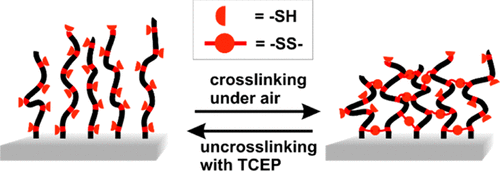当前位置:
X-MOL 学术
›
Macromolecules
›
论文详情
Our official English website, www.x-mol.net, welcomes your
feedback! (Note: you will need to create a separate account there.)
Reversibly Cross-Linking Polymer Brushes Using Interchain Disulfide Bonds
Macromolecules ( IF 5.1 ) Pub Date : 2020-01-14 , DOI: 10.1021/acs.macromol.9b02199 Piotr Mocny 1 , Harm-Anton Klok 1
Macromolecules ( IF 5.1 ) Pub Date : 2020-01-14 , DOI: 10.1021/acs.macromol.9b02199 Piotr Mocny 1 , Harm-Anton Klok 1
Affiliation

|
The introduction of interchain cross-links in surface-grafted polymer brushes increases the robustness and mechanical properties of these thin polymer films. In most cases, cross-linked polymer brushes contain permanent interchain cross-links. The use of reversible interchain cross-links, in contrast, provides opportunities to dynamically modulate the cross-link density and properties of surface-grafted polymer brushes. This study explores the use of disulfide bonds to reversibly cross-link poly(2-(dimethylamino)ethyl methacrylate) copolymer brushes. These brushes were prepared via surface-initiated atom transfer radical copolymerization of 2-(dimethylamino)ethyl methacrylate and an azide-containing comonomer, 3-azido-2-hydroxypropyl methacrylate, followed by copper(I)-catalyzed azide–alkyne cycloaddition of S-propargyl thioacetate and subsequent deprotection of the thioacetate moieties. Heating the polymer brushes to 60 °C under air for 2 h resulted in the formation of disulfide cross-links, which could be reduced to generate the corresponding free thiol groups upon brief exposure to tris(2-carboxyethyl)phosphine hydrochloride. The formation and cleavage of the interchain disulfide cross-links has a profound influence on the swelling and viscoelastic properties of the brushes. Cross-linking leads to a decrease in swelling ratio and a concomitant dehydration and loss in dissipative properties of the brush film. These changes were observed using ellipsometry and quartz crystal microbalance with dissipation monitoring experiments by exposing the polymer brushes to a sequence of successive cross-linking and uncross-linking steps. These experiments indicated that while cross-linking and uncross-linking were fully reversible during the first few cycles, the response of the brush films became less pronounced upon prolonged oxidation/reduction, which was attributed to the oxidation of thiol side-chain functional groups and a concomitant reduction in the cross-link density of the polymer brushes. The results presented in this study show that the incorporation of disulfide interchain cross-links allows access to polymer brush films that can be reversibly cross-linked and uncross-linked over many cycles.
中文翻译:

使用链间二硫键可逆地交联聚合物刷
在表面接枝的聚合物刷中引入链间交联可增加这些聚合物薄膜的坚固性和机械性能。在大多数情况下,交联的聚合物刷包含永久性的链间交联。相反,可逆链间交联的使用提供了动态调节表面接枝聚合物刷的交联密度和性能的机会。这项研究探索了使用二硫键可逆地交联聚(2-(二甲基氨基)乙基甲基丙烯酸甲酯)共聚物刷。这些刷子是通过甲基丙烯酸2-(二甲氨基)乙酯和含叠氮化物的共聚单体甲基丙烯酸3-叠氮基-2-羟丙基的表面引发的原子转移自由基共聚制备的,然后经铜(I)催化的叠氮化物-炔烃环加成S-炔丙基硫代乙酸酯和随后的硫代乙酸酯部分的脱保护。在空气中将聚合物刷在60°C下加热2小时会形成二硫键交联,短时暴露于三(2-羧乙基)膦盐酸盐后,该二硫键可被还原生成相应的游离硫醇基。链间二硫键交联的形成和裂解对刷子的溶胀和粘弹性能产生深远的影响。交联导致溶胀率的降低以及伴随的脱水和刷膜的耗散性能的损失。这些变化是通过椭圆偏振法和石英晶体微天平以及耗散监测实验观察到的,方法是将聚合物刷暴露于一系列连续的交联和非交联步骤。这些实验表明,尽管交联和未交联在最初的几个循环中是完全可逆的,但在长时间的氧化/还原过程中,刷膜的响应变得不那么明显,这归因于硫醇侧链官能团和随之降低了聚合物刷的交联密度。这项研究提出的结果表明,二硫键链间交联的引入使得聚合物刷膜可以在许多循环中可逆地交联和不交联。这归因于硫醇侧链官能团的氧化以及聚合物刷的交联密度的降低。这项研究提出的结果表明,二硫键链间交联的引入使得聚合物刷膜可以在许多循环中可逆地交联和不交联。这归因于硫醇侧链官能团的氧化以及聚合物刷的交联密度的降低。这项研究提出的结果表明,二硫键链间交联的引入使得聚合物刷膜可以在许多循环中可逆地交联和不交联。
更新日期:2020-01-14
中文翻译:

使用链间二硫键可逆地交联聚合物刷
在表面接枝的聚合物刷中引入链间交联可增加这些聚合物薄膜的坚固性和机械性能。在大多数情况下,交联的聚合物刷包含永久性的链间交联。相反,可逆链间交联的使用提供了动态调节表面接枝聚合物刷的交联密度和性能的机会。这项研究探索了使用二硫键可逆地交联聚(2-(二甲基氨基)乙基甲基丙烯酸甲酯)共聚物刷。这些刷子是通过甲基丙烯酸2-(二甲氨基)乙酯和含叠氮化物的共聚单体甲基丙烯酸3-叠氮基-2-羟丙基的表面引发的原子转移自由基共聚制备的,然后经铜(I)催化的叠氮化物-炔烃环加成S-炔丙基硫代乙酸酯和随后的硫代乙酸酯部分的脱保护。在空气中将聚合物刷在60°C下加热2小时会形成二硫键交联,短时暴露于三(2-羧乙基)膦盐酸盐后,该二硫键可被还原生成相应的游离硫醇基。链间二硫键交联的形成和裂解对刷子的溶胀和粘弹性能产生深远的影响。交联导致溶胀率的降低以及伴随的脱水和刷膜的耗散性能的损失。这些变化是通过椭圆偏振法和石英晶体微天平以及耗散监测实验观察到的,方法是将聚合物刷暴露于一系列连续的交联和非交联步骤。这些实验表明,尽管交联和未交联在最初的几个循环中是完全可逆的,但在长时间的氧化/还原过程中,刷膜的响应变得不那么明显,这归因于硫醇侧链官能团和随之降低了聚合物刷的交联密度。这项研究提出的结果表明,二硫键链间交联的引入使得聚合物刷膜可以在许多循环中可逆地交联和不交联。这归因于硫醇侧链官能团的氧化以及聚合物刷的交联密度的降低。这项研究提出的结果表明,二硫键链间交联的引入使得聚合物刷膜可以在许多循环中可逆地交联和不交联。这归因于硫醇侧链官能团的氧化以及聚合物刷的交联密度的降低。这项研究提出的结果表明,二硫键链间交联的引入使得聚合物刷膜可以在许多循环中可逆地交联和不交联。









































 京公网安备 11010802027423号
京公网安备 11010802027423号